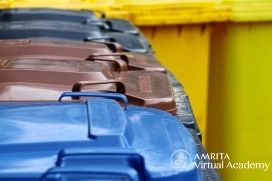
What Happens When It Leaves the Curb?
Ever wondered what happens to your recycling once it leaves the curb? Neither did I until March of 2017 when my waste management facility informed me I could no longer recycle most plastics because China wasn’t taking them anymore. It was a huge wake-up call. I hadn’t been aware my recycling was being sent to China, mainly because I never inquired. As long as it magically went away each week, I felt satisfied I had done my part. Now I know, there is no “away.”
Here’s how it (basically) works: In the US, every city or county has a Waste Management Facility with whom they contract with. These are your ‘haulers’ – the ones who come to the curb, pick up your waste and bring it back to their facility. The garbage is sent to the landfill or incinerator and the recycling is dumped into a big-rig container. Once that container is full, it is driven to the Materials Recovery Facility or ‘MRF’. Pronounced like ‘Smurf’, but with an ‘M’. At the MRF, the recyclables are sorted and the plastics that have a viable market are crushed, baled and most likely shipped overseas. What about the plastics that aren’t viable? No one really knows for sure what is happening to those. I tried calling MRF’s in several cities to ask what their end-markets were. None of them would answer my questions, saying the information was “proprietary.” All I wanted was the truth, but the truth isn’t always convenient.
“Our every action matters to something or someone, somewhere.”
The truth is, only 9% of all plastics ever created have been recycled. Since 1950, we have created 9.2 billion tons of plastic. Of that, more than 6.9 billion tons have become waste. And of that waste, a staggering 6.3 billion tons never made it to a recycling bin, so now we are drowning in it. The great thing about plastic is it’s so durable. The problem is, it’s so durable it doesn’t decompose. It only breaks down into smaller and smaller pieces which we call microplastics. These microplastics can now be found on every beach, in every bucket of water scooped from any ocean, in our sea salt, fish, marine animals, atmosphere, water supply, and in us. It has never been more critical that we heed Amma’s warnings to reduce our consumption of single-use plastics and care for and protect Mother Nature.
What we know today, is there is a still a viable end-market for plastic resins #1 and #2 PET and HDPE – mainly bottles and jugs. They are higher quality and can be more easily recycled or downcycled in actuality. This makes them more profitable and therefore, more desirable. The other types of plastics (#3 – #7) are not easy to recycle or cannot be recycled because they are made from low-quality polymers or have already been downcycled several times. Not to mention most facilities in the United States are not equipped to process them. Additionally, the current low cost of oil per barrel makes it cheaper for manufacturers to use new, virgin plastic than to sort, clean, melt and recycle lower-quality, contaminated plastics. So, what happens to these undesirable plastics?
Well, depending on where you live, the majority are either being landfilled or shipped to end-markets in third-world countries such as Philippines, Cambodia, Ecuador, Vietnam, Turkey, Ghana, Thailand, Bangladesh, Senegal, etc. Right now, alarm bells should be going off. Yes – we are sending our garbage plastics to other countries that can’t even process their own. These developing nations’ are shouldering the burden of developed nations’ over-consumption. So, what are they doing with all of this plastic waste? Good question.

Some of the more viable plastics are melted down and made into “nurdles.” Nurdles are tiny plastic pellets, the size of a lentil or smaller, that serve as the raw material for most plastic products. Due to mishandling and industrial spillage, these pellets are a major source of plastic pollution in their own right. The less viable plastics are piled up in open dump sites, incinerated or processed in recycling facilities, many of which are operating illegally without any regard for the environment or the safety, health and well-being of the people working there.
One of the most important things to realize is when we collect and remanufacture plastic, we are only delaying its disposal as it can only be downcycled so many times. The final destination for all plastic is either a landfill, where it doesn’t decompose, or an incinerator, where it releases harmful chemicals when burned, or the environment in some form of pollution.
So, is there any good news? Well…Yes! YOU are! You CAN make a difference! At the end of Amma’s 2019 New Year’s Message, one of the questions she posed to each of us was, “Am I able to contribute and play my part in protecting the environment?” We can all contribute and play our part if we:
· REFUSE – what we don’t need. Manufacturers’ will stop making when we stop buying.
· REDUCE – single-use and unsustainable items.
· REUSE or REPURPOSE – what we already have.
· REPAIR – rather than throw away, there is no away.
· RECYCLE – what we can.
· RALLY – your elected officials to pass legislation on single-use plastics.
And remember, no action toward the care, protection and conservation of nature is ever too small or insignificant. Our every action matters to something or someone, somewhere.
Click here to explore our Ecology courses!
Links
https://news.nationalgeographic.com/2017/07/plastic-produced-recycling-waste-ocean-trash-debris-environment/
https://www.nationalgeographic.com/magazine/2018/06/plastic-planet-waste-pollution-trash-crisis/ https://www.nurdlehunt.org.uk/whats-the-problem.html
https://www.theguardian.com/us-news/2019/jun/17/recycled-plastic-america-global-crisis
